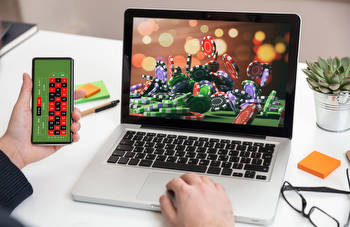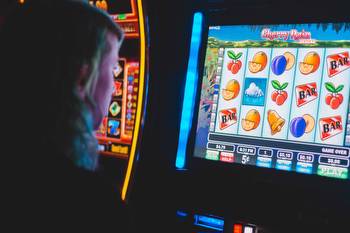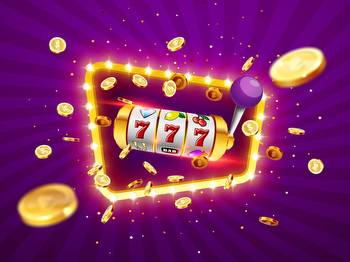Slot Machines are a Harbinger of the Coming Media Landscape
The Same Dynamics that Built Powerfully Addictive Slot Machines will Shape the Future of Digital Media
On a road trip through the American Southwest this February, I visited Las Vegas. It was the first time I’d been there in my adult life. I approached the city with ample preconception. Hunter S. Thompson’s Fear and Loathing in Las Vegas was the second or third book I had read in my life, and was still floating around the bedrock of my literary consciousness. I had watched Casino and various documentaries about washed-up performers who went there to die, heard friends and coworkers debrief their vacations, and read the seminal study of its architecture and urban form Learning from Las Vegas. I expected something big, fun, tacky, imbued with paranoid evil.
That was more or less what I encountered, if only in a diminutive and Disneyfied form. The one impression that really defied my expectation was just how dominated the city was by slot machines. I expected Casinos to be filled with cards and craps tables, roulette wheels, ecstatic people crowded around some spectacle. While these things existed, they did so as small islands in a sea of slot machines. The slack-jawed gamblers at these machines looked, by all appearances, to be bored, lonely, tired.
The screens of the slot machines were massive and sloping, appearing to fold the gamblers into them. Deep, half-reclining seats cradled the users directly in front of them. I sat down in one for curiosity’s sake. With my eyes angled parallel to the floor, the display extended past the upper periphery of my field of vision, roughly aligned with the lower periphery, and extended deep into the right and left. On the screen, there was an animated woman in an imperial Chinese dress, and the sprawling graph of slots left behind from the previous roll. In terms of its immersive power, it was more like an iMax theater than VR- still fundamentally just a screen in front of you, but one with a much stronger gravitational pull than a computer or TV screen.
An apparent contradiction of contemporary slot machines is the numbing simplicity of play and the fantastic complexity of mechanic. Unlike cards or even dice games, with a set of simple rules that dictate informed strategies with their own unique play styles, edges, and win frequencies, slots players only need to know how to press a button to achieve the exact same statistical outcome as the most experienced player.
However, what happens once that button is pressed is an operation of almost unfathomable complexity. The slot machines which now dominate casino floors worldwide are not like the iconic ones of old, in which one pulls a lever and hopes to see a row of lucky symbols populate a line of 3 or 5 slots. Rather, they have electronic matrixes of up to 8 slots in width and 8 slots in depth. Players do not bet a dollar, for example, on the outcome of one line, but rather one cent on the outcome of 100 possible lines drawn through the graph of slots. It would take perhaps 2 hours to visually interpret the results of a single spin and tally one’s winnings.
The average time between spins, meanwhile, is between four and five seconds. After each spin, accompanied by all manner of bells and whistles and lights, a player might ‘win’ on 7 lines and ‘lose’ on 93, resulting in either a slight net win or a slight net loss. The house edge on these machines is typically between 5 and 10%, and this multi-bet mechanism makes the outcome of any given spin approximate the average much closer than it would on a single-line bet, resulting in a steady, meditative depletion of funds.
My sole trial of a machine resulted in a swift and punishing loss of $15 in over 7 spins, leading me to walk away and never turn back.
We stayed in Vegas for two days, and while we were there I became fixated on the slots players. Each casino had hundreds of these machines and about half of them were in use at any given time. Players sat before them as if in a trance, staring through dead eyes at the screen as they poured more and more irretrievable earnings into them. It was as if the machines had the power to reliably produce an obsessed hypnosis in its players. The machines had a kind of dark energy that I could marvel at, but not understand.
Once we left, I set out to develop a better understanding of the machines. The story of their development and rise to ubiquity is a fascinating one. The first slot machine was invented in New York in 1891, and installed in bars. A patron would insert a cent to purchase a spin, which would set five reels into motion. An entire deck of cards was spread over the faces of the five reels, so each spin would result in a viable poker hand. There was no payout mechanism, so each bar could set its own rules for the machines. Hands above a certain value might pay out a free beer, hands below a certain value would pay out nothing.
In 1899, Charles Fey of San Francisco invented a version of the machine that could make automatic payouts. The new machines spun three reels, each of which displayed 5 symbols. This reduced the number of possible outcomes from 100,000 to 125, allowing the machine to ‘read’ outcomes and dispense or withhold coins accordingly. The “Liberty Bell” machine was immensely successful, spawned many imitations, and within a few decades slot machines were a staple, if not a defining feature, of most gambling institutions.
The design and functionality of slot machines would improve incrementally until the late 1970s, when fully electronic video slot machines were brought to market. This laid the groundwork for a technological renaissance in the industry. An immense number of variables were now under the game designer’s control. The audiovisual displays of games became independent of the outcome-generating mechanism. The number of possible outcomes became virtually infinite. Jackpot amount, win frequency, the specific house edge, etc could all shift within the course of a single play session. The machines could store credits and even link directly to bank accounts, allowing for much higher wagers, smoother payouts, and eliminating the time spent reloading machines in between wagers.
Naturally, all of these new variables were to be manipulated in order to create machines with the greatest possible revenue-generating capacity. The slot machine industry quickly became a multi-billion dollar one, and massive amounts of corporate R&D money were funneled into this goal. One particular performance indicator soon became the industry standard for gauging a machine’s success: time-on-device, or the amount of time a typical user would spend playing the machine before deciding to cash out. The machines that resulted from this effort were successful in maximizing this metric, and correct in their analysis that it was critical for maximizing the devices' revenue-generation. Unsurprisingly, machines that are fine-tuned to keep users glued to them for as long as possible profoundly manipulate the psychology of users, and leverage pathological and addictive tendencies to do so.
The human experience of addiction to slot machines is the subject of Natasha Dow Schull’s 2012 book Addiction by Design. The book provides a compelling and comprehensive look into the experiences of machine-gambling addicts, focusing primarily on the affective states and personal narratives characteristic of their addictions. Slot machine use, amongst the people surveyed in the book, is almost never driven by a desire — or hope — that the user might cash in on a huge win. The users almost universally understand their machine gambling to be a pure expense. They consider their credits not in terms of their real-world monetary value, but rather, for their ability to buy them time on the device. A ‘lucky’ session is one that allows them to play for a long time before depleting their credits, an unlucky session is one where the funds dry up too quickly. Either way, nobody expects to come out ahead.
This stands in stark contrast to sports betting or some card games, where players really are driven by the belief that they stand to benefit from the action. Slot machine players understand the product much differently. They are not risking money for a possible greater reward, but rather exchanging money for a desirable, or at least compelling, affective state.
Dow Schull refers to this state as the “Machine Zone” and dedicates much of the book to exploring its nature and preconditions. The experience of being in the Machine Zone is roughly equivalent to a flow state. The user becomes so thoroughly absorbed in the activity that they lose the sense of time, place, and bodily function. The stressors and complications of real life disappear into the trance-like flow of machine play. It’s a state that users are unable to reproduce by any other activity, and which has a tremendous, even narcotic hold on them. Crucially, in this Machine Zone users report losing track of the monetary value of credits entirely- once they’re in the Machine Zone, only the machine world exists.
The stories that machine addicts share in the book are harrowing. One player recalls getting off work, sitting down in front of a machine for a quick session, and the next time she checked a clock, discovering that she was 2 hours late for work the next day. Another recounts how she would put on thick wool pants before slot machine sessions so that she could urinate in them and avoid having to discontinue play to go to the bathroom. Heart attacks amongst players who had ignored signs in order to keep playing were surprisingly common, and considerably more lethal than typical heart attacks, in light of the difficulty EMTs face parking and navigating through the casino. These more dramatic stories all fall against a backdrop of countless others who depleted life savings, retirement funds, and wasted years of their lives.
The story of how gambling machines became empowered to produce this state is a fascinating, if cautionary one. Game developers were set the task of maximizing time-on-device. Casino proprietors had long been in the practice of collecting massive amounts of data about their customers and were willing to purchase increasingly sophisticated data collection instruments for their own purposes. Game developers thereby had access to unfathomable amounts of data about the habits and tendencies of slot-machine users. This created a cycle in which any innovation in game design could swiftly have its effect gauged across a host of different metrics, allowing for product development to proceed with an unprecedented amount of direction and certainty. The resulting products, which are part of a still-ongoing process, were profoundly effective at leading users to spend greater and greater amounts of time playing, and by extension, spending greater and greater amounts of money.
The massive addictive potential of slot machines, the eerie trance state they induce in users, and the huge revenues they generate for casinos and manufacturers would likely not have been possible if not for this very specific economic arrangement of data collection and attention-monetization. This economic arrangement is eerily similar to the one that has more recently formed around digital media platforms. With these platforms, maximizing time on the device is the surest way to maximize advertisement revenue. Digital media platforms are similarly empowered to collect massive amounts of data on their users’ habits and tendencies.
Certain internet media mechanics have already been identified and analyzed in light of their similarity to slot-machine mechanics. Any given spin of a slot machine does not guarantee a ‘hit,’ i.e. a positive, reinforcing outcome. Players persevere through losses for an undetermined period of time before a surprise win. This simultaneously accentuates the win and reinforces the player's persistence through earlier losses, thereby encouraging longer overall play sessions and inoculating players with the sting of losses. Users of scrollable short-form video platforms like TikTok, Youtube Shorts, and Instagram Reels encounter a very similar dynamic, in which persistence through a string of unentertaining videos is eventually rewarded by a particularly entertaining video. The addictive quality of this variable ratio reinforcement schedule in internet media platforms has been dubbed “the Vegas Effect’’ by writers in Psychology Today and other popular outlets. Perhaps as a consequence of this mechanic, ‘doom-scrolling’, like the “Machine Zone,” has been productively compared to flow states.
The parallels between specific mechanics and their psychological effects worry me much less than the core similarity of the two industries’ economic dynamics: massive data collection being leveraged to capture maximum time from users. This dynamic places internet media on the same developmental trajectory that slot machines took in the late 1970s. The unanswerable question of what internet media will go on to become, in light of what it is economically incentivized to become, is what concerns me.
The differences between the two economic dynamics actually do more to compound this concern than to alleviate it. Slot machines are illegal in most jurisdictions of the world, and in the US generally require a long road trip to access. Digital media is, in contrast, probably the most accessible commodity that has ever existed. The maximum market share of slot machines, and by extension the amount of R&D money that can flow into accelerating product innovation, has a natural cap much lower than digital media’s. The amount of data that can be collected on a casino patron in the 1980s or 1990s pales in comparison to that which can be collected on the contemporary consumer of digital media. The auxiliary incentives for collecting data on consumers of digital media, who more closely approximate the general consumer than a casino patron does, are also far greater. The economic dynamic that will drive the development of digital media technology is a hyper-empowered version of what has driven the development of slot machines to this day.
It took video slot machines only a few decades to become so powerfully addictive that users began to choose what pants to play in based on their ability to absorb urine. What dark hold might digital media be similarly equipped to take on us in a few decades?






























